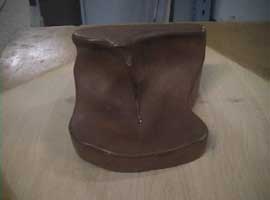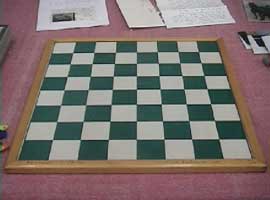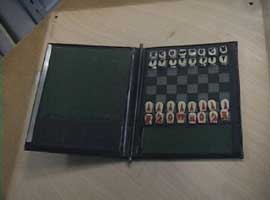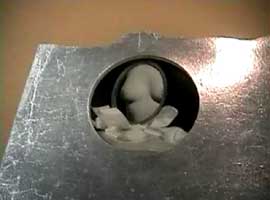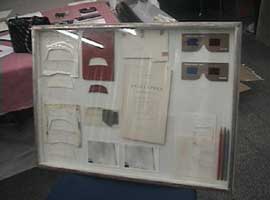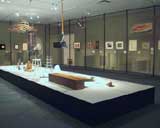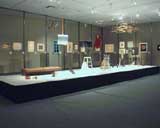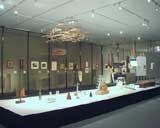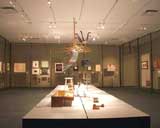|
.
. . and may I, who am still searching for something in this world,
be left with open eyes, or with closed eyes in broad daylight,
to my silent contemplation.
André Breton, Le surréalisme et la peinture, 1928
|
Click
to see video
|
|
|
|
video1(1.4mb)
|
|
Marcel
Duchamp, Why Not Sneeze Rrose Sélavy?, 1921/1964 © 2000
Succession Marcel Duchamp, ARS, N.Y./ADAGP, Paris
|
The vast
collection of works donated by the Milanese scholar, poet, and collector
Arturo Schwarz as a gift to the Israel Museum at the beginning of 1998
was an offering of unique scope and importance. Consisting of about
750 works by approximately 200 artists in a variety of styles and techniques,
the Vera, Silvia, and Arturo Schwarz Collection of Dada and Surrealist
Art constitutes the major part of the total collection amassed by Arturo
Schwarz. (The other parts are to be found in the National Gallery of
Modern Art in Rome and the Tel Aviv Museum of Art.) This is one of the
world' s greatest collections of Dada and Surrealist art, and since
its addition to the Museum's existing holdings, which include the collector's
extensive library, the Israel Museum has become a global center for
the study and display of these two seminal movements in modern art.*
Arturo
Schwarz' s connection with the Israel Museum began in 1972, when he
gave the museum a set of thirteen replicas of Marcel Duchamp's readymades.
During the Gulf War of 1991, he decided to donate most of his collection
and his entire library to the Israel Museum, and already in 1992 we
received the vast library containing more than a thousand items, including
limited-edition books, many with original prints, and full runs of Dada
and Surrealist periodicals, as well as documents, manifestos, and Schwarz'
s extensive personal correspondence with the movements' leading figures.
Arturo Schwarz was born in 1924 in Alexandria, Egypt, to Jewish parents:
a German father and an Italian mother. In his youth, he was very active
in clandestine political circles. At first he was affiliated with the
Zionist movement and spent several months on a kibbutz in Palestine;
later he became involved in a Trotskyist group in Alexandria. At the
same time Schwarz made the acquaintance of the Egyptian Surrealists
and from 1945 to 1948 ran a publishing company and a bookstore. Arrested
several times for his political activities, he was expelled from the
country in 1949. He settled in Milan, where he founded another publishing
house and, at the beginning of the 1950s, opened a bookstore which later
developed into Galleria Schwarz, which closed in 1975. The gallery held
exhibitions of the best Dada and Surrealist artists and of contemporary
artists throughout the world. Simultaneously, Schwarz wrote poetry,
published scholarly books such as a catalogue raisonné of the works
of Marcel Duchamp, gave lectures and organized international Dada and
Surrealist exhibitions. His intense involvement in the Surrealist movement
and his personal acquaintance with many of its members made him a leading
authority on its history.
Arturo Schwarz wrote that "Dada was the first movement in the history
of art to liberate the creative process from the shackles of rules and
academisms . . . and in Surrealism I discovered a philosophy of life
whose cardinal points - love, freedom and poetry - coincided with my
own. I have thus never seen myself as an 'art collector' but rather
as a convinced Surrealist, keen to acquire the works which were inspired
by my own convictions." Indeed, the imprint of his life and personality
is manifest in the collection he assembled for years, and the personal
portrait reflected in it reveals a combination of two seemingly opposite
forces: a romantic-surrealistic vision of imagination, dreams, and love
is countered by the critical eye of a scholar and historian who wishes
to investigate, to document, and to explain. On the one hand, there
is a passion for collection and a spirit of adventure; on the other,
methodical assemblage and scholarly classification. Schwarz's deep conviction
that Surrealism is not only an artistic-stylistic trend but a universal
spiritual and ideological manifestation that seeks "to break the habit
of looking at things in the same way, to revolutionize our vision" is
evident in his desire to capture and document every cultural, geographical,
and historical aspect of the phenomenon. Thus, his collection contains
oil paintings alongside photographic portraits, and books of poetry
next to documents, representing a range from Europe to South America
and from the sixteenth century to the present. His selection disregards
both conventional aesthetic distinctions and any accepted hierarchy
of major and secondary works or important and unimportant artists. The
result is an encyclopedic cultural mosaic that is impressive and astonishing,
especially if one takes into account that it is the lifework of a single
individual. Schwarz has explained his criteria by saying, "It is not
physical beauty that interests me; it is spiritual beauty and the idea
behind it, and when it is strong enough it becomes physical beauty,
but not the other way round."
|
Click
to see video
|
|
|
|
video2(1.4mb)
|
|
Marcel
Duchamp, Female Fig Leaf, 1950/1951 © 2000 Succession Marcel
Duchamp, ARS, N.Y./ADAGP, Paris
|
At the
end of the year 2000, the Museum will present a major sampling of the
Vera, Silvia, and Arturo Schwarz Collection to the public for the first
time. Combining Schwarz's insight and personal approach to collecting
with a museological, historical presentation of Dada and Surrealist
art, the exhibition Dreaming with Open Eyes will feature 350
representative works in a variety of techniques - paintings, drawings,
collages, prints, photographs, sculptures, and readymades - along with
dozens of items from the unique library of periodicals, documents, and
books. A short introductory film presents the life story of Arturo Schwarz
through personal photographs and excerpts from interviews. Using contemporary
design language, the exhibition conveys the radical spirit of these
two movements. Occupying several galleries, it is arranged by topic
as well as in historical order, largely reflecting the main divisions
of the original collection.
"Dada Doesn't Mean Anything"
The Dada movement, which came into being in Europe and the United States
in protest at the horrors of the First World War, rebelled against artistic
convention and sought to subvert the existing social and political order.
The works exhibited, whose main source is the legacy of one of the leaders
of Dada, Tristan Tzara, represent the oeuvre of such major artists as
Marcel Janco, Jean Arp, Raoul Hausmann, Max Ernst, Francis Picabia,
and Kurt Schwitters. Mainly drawings and collages, they exemplify typical
elements of Dada: the accidental, the absurd, protest, and criticism.
The Dadaists' desire to fuse life and art and to embrace all areas of
creativity is reflected in the accompanying display of their radical
periodicals and manifestos, together with excerpts from the early films
of Hans Richter.
The Chess Players: Marcel Duchamp and Man Ray
|
Click
to see video
|
|
|
|
video3(1mb)
|
|
Marcel
Duchamp, Chessboard, ca. 1946
© 2000 Succession Marcel Duchamp, ARS, N.Y./ADAGP, Paris
|
|
Click
to see video
|
|
|
|
video4(1.7mb)
|
|
Marcel
Duchamp, Pocket Chess Set, 1943/1961~64
© 2000 Succession Marcel Duchamp, ARS, N.Y./ADAGP, Paris
|
The revolutionary
work of Marcel Duchamp and Man Ray had a profound influence on Dada
and Surrealist artists and on later trends in twentieth-century art.
Arturo Schwarz began to correspond with Marcel Duchamp in the early
1950s and through him made the acquaintance of Man Ray. He demonstrated
his deep appreciation of these two artists and his devotion to them
by arranging exhibitions, producing series of readymades, acquiring
dozens of their works and writing authoritative scholarly books about
them. The seventy works by these two artists in the exhibition, which
demonstrate their conceptual approach and bear witness to their fertile
imaginations, are replete with irreverence, iconoclasm, humor, playfulness,
sexuality, and eroticism.
|
Click
to see video
|
|
|
|
video5(1.5mb)
|
|
Marcel
Duchamp, In the Manner of Delvaux, 1942
© 2000 Succession Marcel Duchamp,
ARS, N.Y./ADAGP, Paris
|
"Pure
Psychic Automatism": Surrealism
The ideologues
of the Surrealist movement, whose conceptual platform was formulated
by André Breton in the First Surrealist Manifesto of 1924, wished to
develop patterns of thought and expression which would lay bare an inner
irrational and subconscious reality like that revealed in dreams, psychoanalysis,
and the drawings of children and the insane. Surrealist artists experimented
with automatism as a basic principle of random and unmediated creativity,
and with illusory dream images in fantastic forms and surprising combinations.
In this part of the exhibition, there is a rich collection of more than
a hundred works from various periods. Among the artists exhibited are
some of the members of the original circle of the Surrealist movement
in the 1920s and '30s, such as André Breton, Joan Miró, Yves Tanguy,
André Masson, and Max Ernst, and others who were influenced by it and
joined after the Second World War, like Victor Brauner, Wifredo Lam,
and Matta. A prominent place is occupied by women artists like Claude
Cahun, Remedios Varo, Kay Sage, Dorothea Tanning, and Meret Oppenheim.
The works on show illustrate the variety of methods used by the artists
to liberate their imaginations from the domination of the critical consciousness,
ranging from automatic drawing, collage, and photomontage to collective
drawings, dream pictures, and assemblage.
"The Sleep of Reason": Forerunners of Surrealism
From the very beginning of the Surrealist movement, writers and artists
turned to the works of the past for inspiration and affirmation. In
art and literature, they did, in fact, find evidence of a timeless interest
in dreams, the supernatural, the magical, and the irrational. In the
art of the Middle Ages, the Renaissance, and the Baroque, these elements
were to be found in such subjects as the Apocalypse, monsters, alchemical
symbols, scenes of temptation, and erotica, and in grotesque and hybrid
images. From the beginning of Romanticism in the eighteenth century
to the Symbolist movement in the nineteenth, the taste for fantasy and
the irrational grew stronger: the industrial era gave rise to anxiety
and to a longing for a mystical, otherworldly experience. Like Breton
and others, Arturo Schwarz assembled examples of pre-Surrealist works
characterized, as he said, by "their spiritual attitude toward the marvelous
- as well as their subversive element." This variegated collection includes
paintings, prints, and drawings dating from the sixteenth to the twentieth
century by artists such as Dürer, Goya, Moreau, and Redon, along with
tribal masks and artifacts from Africa, Oceania, and North America.
|
Click
to see video
|
|
|
|
video6(1.1mb)
|
|
Marcel
Duchamp, Cheminée anaglyphe (Anaglyphic Chimney)and related
material, 1968 © 2000 Succession Marcel Duchamp, ARS, N.Y./ADAGP,
Paris
|
Talking
Heads:
The Library Portraits of Surrealist artists and writers immortalized
by their photographer and painter colleagues constitute a separate section,
which Arturo Schwarz calls "memorabilia." These works have a special
value, apart from their documentary and historical importance, in that
they shed light on the personal relationship between the artist who
depicts and the person depicted. The collection of portraits is combined
with a selection of Dada and Surrealist books illustrated with original
prints. There are also artists' books in special editions by Max Ernst,
Man Ray, Masson, Picabia, and others, and books produced jointly by
pairs of artists like Tristan Tzara and Jean Arp, Benjamin Péret and
Yves Tanguy, Robert Desnos and Pablo Picasso, and Paul Eluard and Man
Ray. The collaboration between artists manifested in these portraits
and books illustrates the intellectual ferment of Surrealism and the
spiritual bond that existed among the members of the movement.
The exhibition will be accompanied by a comprehensive 250-page catalogue,
which includes an illustrated inventory of all the works in the Vera,
Silvia, and Arturo Schwarz Collection in the Israel Museum. An exploration
of a perennially fascinating subject, Dreaming with Open Eyes
promises to be one of the Museum's most important and enlightening exhibitions
as we begin the new millennium.
* For more on the collector and his gifts to the Israel Museum, see
The Israel Museum Journal XVI (1998): 61-70.
Installation
views of the exhibition's Marcel Duchamp and Man Ray section
|
Click
to enlarge
|
Click
to enlarge
|
Click
to enlarge
|
Click
to enlarge
|
|
|
|
|
|
|
The
Vera, Silvia and Arturo Schwarz Collection of Dada and Surrealist
Art, Israel Museum, Israel, 2000
|
|

